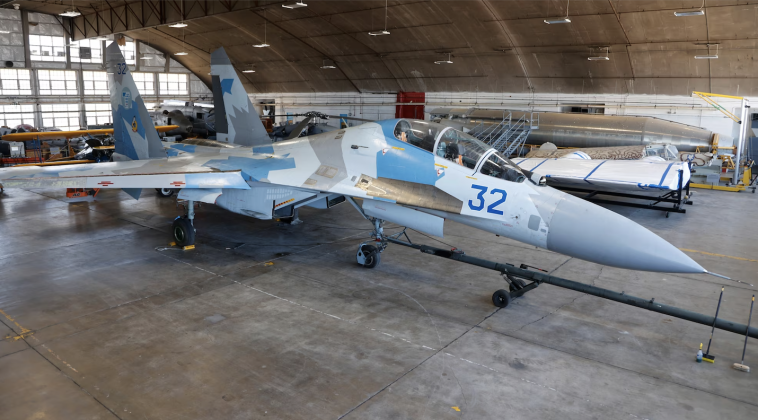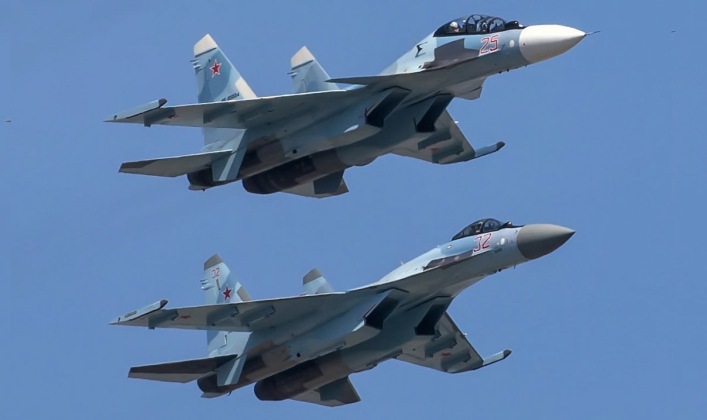News
How America Acquired the Soviet Union’s Top Fighter Through Ukraine: Su-27s in Roles From Aggressor Training to Oil Exploration

Following the disintegration of the Soviet Union in December 1991 the United States Military gained access to multiple kinds of highly sensitive Soviet weapons technologies through acquisitions from newly independent successor states. This process had begun from 1989 when, following the disintegration of the Warsaw Pact, a study of Soviet military hardware exported to Eastern European states, and particularly to East Germany which had often fielded some of the most capable equipment available, was prioritised as a means of gaining advantage in a future conflict with Russia or the many states which fielded its hardware. This in many cases led to reverse engineering efforts to close technological gaps between American weapons systems and their Soviet counterparts. One of the most famous examples was the development of the AIM-9X air to air missile with high off boresight targeting capabilities – meaning it could engage targets at extreme angles using cues from a pilot’s helmet mounted sights – a capability pioneered by the Soviet R-73 air to air missile deployed by MiG-29 and Su-27 fighters. Although MiG-29s the U.S. Air Force faced over Iraq in 1991 did not have R-73 missiles, which was key to allowing F-15s to tackle them in multiple visual range engagements, those deployed by East Germany did, which was seen to provide an overwhelming advantage at visual ranges. The R-73 was accordingly studied closely when developing the AIM-9X.
After the USSR disintegrated the country’s top fighters the MiG-29 and Su-27 were acquired in the 1990s from the successor states of Moldova and Belarus respectively for testing and adversary training purposes in the United States. A secondary purpose for the purchase from Moldova was to derail a deal then in the making for the sale of these fighters to Iran, which had acquired MiG-29s from the Soviet Union and sought to further expand its fleet, but been prevented from doing so through purchases from Russia as Washington successfully pressured Moscow to cease further sales. The sales of two Su-27s by Belarus represented part of an effort by the country to divest itself of aerial warfare assets which it could not afford to maintain. The country’s elite MiG-25BM air defence suppression aircraft were quickly retired, while its Su-24M strike fighters were placed in storage with a portion of them then sold to Sudan. Su-27s remained in service but were retired in 2012 due to their perceived excessive operational costs, with the Air Force instead relying on less capable MiG-29s for its air defence.

With Belarusian Su-27s were based at Area 51 for testing purposes, the private firm Terralliance Technologies sought to acquire the same aircraft to repurpose them for oil exploration. The firm sought oil exploration opportunities across four continents, and required a long ranged aircraft suitable for mapping which could accommodate large customised sensors. The Su-27’s much longer range and larger sensor suite than any fighter fielded by Western air forces, and the availability of the aircraft from Ukraine which had inherited over 70 airframes, made it appear an optimal choice. Two Ukrainian Su-27s were purchased for this purpose for just $22 million, with these disassembled and modified to integrate Western avionics. With Su-27s having begun entering service in the Soviet Armed Forces from 1984, and many of the aircraft from older production batches based in Ukraine, the aircraft sold had been built in 1988 and were two of the newer models in the Ukrainian inventory. Although there had been significant demand internationally for new Su-27 fighters in the 1990s, with Russia exporting over 100 to China and several more to Vietnam, Ethiopia and Eritrea, by the 2000s newer Su-30 fighters had lower operational costs and far more efficient performances with newer airframe designs using composite materials. Ukraine’s limited defence budget and the lack of perceived threats, with relations with both Russia and the West remaining positive at the time, meant the country could not afford to operate all the Su-27s in its inventory regardless.

With Terralliance running out of funding in 2009, the year the Su-27s were first flight tested following their modification, the aircraft were never used for oil exploration and were sold on to the U.S. government. The fighters were then operated by the firm Tactical Air Support, which offered contract adversary air services to the U.S. Military. The Su-27 and its derivatives the Su-30 and Chinese J-11 at the time formed the backbone the fleets of all the leading air forces outside the Western sphere of influence, including Russia, China, India and Algeria, with Iran at the time also reported to be negotiating an acquisition. Although the Su-27 family of fourth generation fighters were expected to be succeeded from the early 2000s by the MiG 1.42 fifth generation air superiority fighter, the decline of the Russian economy and tech sector in the 1990s prevented this from ever being realised with the program terminated in 2001 after years of delays.

Forty years after the Su-27 first entered service, the Russian Air Force today continues to rely on derivatives of the design to form the backbone of its combat fleet, with three separate models the Su-30, Su-34 and Su-35 all in production in parallel for domestic use and for a growing range of defence clients. The Su-27 family no longer represent a premier threat to American air superiority as they did in the 2000s, however, with the backbone of the Chinese fleet increasingly formed by the much more advanced J-20 heavyweight fifth generation fighter. China’s Navy and a number of export clients are meanwhile set to soon begin operating the FC-31 – a medium weight fifth generation design which is also considered far superior to any Su-27 derivative. The resulting increasingly limited need for Su-27s for aggressor training roles led the former Ukrainian Air Force Su-27s to be relegated to the Cold War Gallery at the museum at Wright-Patterson Air Force Base in 2023.












